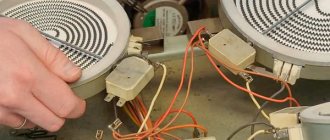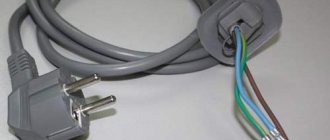Regardless of the parameters and functionality of the devices, you must adhere to the rules of operation and care for them, otherwise they will fail or even break down. Particularly curious owners conduct various experiments with equipment, which is strictly prohibited. So, for example, many people are interested in what happens if you turn on an empty microwave? Is it possible to do this? Everyone knows that the more you forbid, the more you want. Let's consider what this action entails.
When buying any item or equipment, you want to come home as soon as possible and try out the purchase. So, most uninformed buyers bring home a brand new microwave oven, put it on the table, connect it to the electrical power supply and... turn on one of the modes. Everything would be fine, but there is nothing at all in the inner chamber and this is a big mistake! Why, you ask, did nothing happen?
To understand what will happen to the microwave if you turn it on with an empty chamber, you need to familiarize yourself with the principle of its operation.
Operating principle of a microwave oven
A microwave oven operates using electromagnetic waves. Their length ranges from 1 millimeter to 1 meter. Microwaves alone are not enough to heat food; additional molecules are needed, which are a component of all products. One end of the molecule is positively charged, and at the other end there is a negative electrical charge.
Each particle of the product contains a large number of dipole molecules, which move randomly without an electric field. With the appearance of an electric field, all molecules with a positive charge line up in one direction, and those with a negative charge in the other. As soon as the electric field changes its direction (this happens due to the rotating plate), the molecules immediately turn 180 degrees. Thus, they change polarity 4,900,000,000 times per second, and at the same time rub against each other. As a result, heat is released, with the help of which our food is heated.
Microwave oven device
The inner chamber of a microwave oven is made of metal so that it reflects microwaves to the food.
How does a microwave oven work?
In any microwave oven, behind the dashboard there is a special high-voltage vacuum device - a magnetron. It allows you to emit electromagnetic waves with a length of 1mm to 1m,
Microwave oven diagram
Due to the fact that the internal metal walls (in rare cases, ceramic or enameled) of the microwave oven reflect the magnetic radiation generated by the magnetron and subsequently sent along the waveguide, there is some effect on additional water molecules and other elements with positive and negative charges. This activates the process of heat release, which allows you to quickly heat food in the microwave from the inside.
Turning on an empty microwave: to be or not to be
So we have come close to the question: is it possible to turn on an empty microwave oven? To say “you can’t” is to say nothing; you need proof.
So, when a microwave oven is turned on, regardless of the selected function, it produces microwaves that must be absorbed. And since a microwave is a household kitchen appliance, foods should absorb the waves: vegetables, fruits, ready-made dishes. What happens when working with an empty camera?
When the generated microwaves do not encounter any obstacles in their path, they continue to move forward and are reflected from the inner metal walls of the chamber. This process continues until the timer goes off and the device turns off. Nothing is visible to the naked eye: the microwave does not spark, does not crack, does not shoot, but... The concentrated radiation energy adversely affects the main parts of the microwave oven and the magnetron in particular, which will eventually lead to breakdown of the device. And if the magnetron breaks, then there is no point in repairing the microwave oven, since this part costs a little less than the device itself. Then it’s better to buy a new microwave.
Burnt mica plate of microwave oven
To check the device’s functionality, you can place a regular glass of water to heat it up.
There is also a minimum weight of products, which is 200 grams. Therefore, you cannot warm up, for example, one pie or make one hot sandwich. The weight and volume of these products is not enough to absorb all electromagnetic waves, some of which will be reflected from the walls of the device, which will damage it.
Pointed question
So, is it possible to turn on an empty microwave? Let's give the answer right away - no. Now you can begin to explain and argue. Those of us who scrupulously study various types of operating instructions for household appliances probably know that microwave oven manufacturers prohibit turning on their products without putting something in them that, in principle, can be heated. But we understand that all manufacturers in general, and microwave ovens in particular, do not allow many of the things that each of us has done at least once in our lives to be done with their masterpieces.
There is hardly a person in the world who has never put a plate with a golden rim in the oven, or forgotten to remove the fork from a container of food, or left the lid of a container with lunch tightly closed. As a result, the microwave “said” its angry “bang-bang” or “trrr”, hummed and sparkled, but continued to work safely. Therefore, the question of whether it is possible to turn on an empty microwave is not a pressing issue for many. Treating it this way does not carry the risk of instant damage; rather, it is its slow but sure “killing.”
Is microwave radiation dangerous?
Microwave radiation is completely safe. The main thing is to operate the device according to the attached instructions. Thanks to the tightly closed door and blocking system, it is impossible for rays to penetrate outside. And if microwaves leave the oven chamber, they quickly fade out in the atmosphere, so they do no harm (for more details, see the article about the dangers of microwaves: truth or myth?
The only way microwaves can be dangerous is if you grab a hot plate with your bare hand and get burned.
FAQ
Let's consider the most frequently asked questions from users, the answers to which will help prolong the performance of the equipment or dispel doubts.
Are microwaves dangerous?
The designers and developers of these electrical appliances took full care of the safety of the equipment. Therefore, the radiation, while remaining within the chamber, is absolutely not dangerous to the human body. If you start a microwave with the door open, of course, the consequences can be dire, but today all models are equipped with a modern security system that prevents the magnetron from working if the chamber is open.
If there are gaps in the housing through which the waves escape, they quickly attenuate without causing harm. The only danger of the device is the possibility of a burn on the plate if it is made of material unsuitable for microwaves. Read more in the article about dishes that should not be placed in the microwave.
Are the waves radioactive?
Microwaves are non-ionizing radiation and do not involve radioactive exposure. As mentioned above, the heating process occurs due to the friction of molecules, which is not dangerous.
Do the products still have benefits?
The breakdown of some nutrient particles is no higher or lower than when cooking using conventional methods.
Is the water overheating?
Remember how water boils on a stove: it is heated from below, and air in bubbles rises to the surface. Microwave heating has a comprehensive effect, so when you take out a glass of water, you can provoke a boil and scald yourself.
Is it possible to overheat water
The fact is that heating water in the usual way is different from heating it in the microwave. If you boil a liquid on the stove, heating occurs from below, and we see air bubbles rising. When heating water using microwaves, this does not happen, because it warms up from all sides and can overheat.
When taking out a glass of water, you need to be extremely careful: even the slightest push can cause the water to instantly boil and pour boiling water out of the container.
Answers to burning questions
Are microwaves radioactive?
Microwaves are non-ionizing radiation; if you come across any information about radiation, don’t believe it, it’s nothing more than a myth. Heating is carried out exclusively during the friction of hydrogen molecules - this is not dangerous.
Is nutritional value lost?
Some of the nutrients are indeed destroyed, but exactly the same effect occurs when cooking on a gas, electric, induction stove or oven.
Is it possible to overheat water?
There is a difference between the traditional method of heating water and heating in the microwave. When boiling on a stove, heating comes exclusively from the bottom, so air bubbles run up the walls. A microwave does not cause this effect - the water warms up throughout the entire volume, so it can overheat.
Be carefull! When removing a glass of water from the chamber, be careful: a small push can cause instant boiling and splashing of boiling water.
Is it worth boiling eggs in a microwave oven?
Finally, let’s look at a question that worries many users: can you put eggs in the microwave, if not, then why? It's simple: food that is coated and consists primarily of liquid can explode due to increased pressure inside. By placing a closed lunchbox on a rotating plate, you will achieve the same effect - the lid will fly off, making a pop.
We hope that you have much less doubt about the use and general advisability of purchasing a microwave oven. Make your life easier without fear of harming your body, and do not turn on the device when the chamber is empty.
How to extend the life of household appliances?
First of all, you should not turn on an empty microwave. In addition, when heating food in the microwave, it is better to use only utensils designed for this purpose. You can, of course, do this in simple glass or ceramic containers, but they also become hot when exposed to microwave radiation, which does not happen with special plates and mugs.
It is very important to properly care for your microwave oven. It is strictly forbidden to wash the camera with abrasive agents and aggressive chemicals, because they destroy its surface. It is best to remove dirt immediately after using the oven by wiping it with a damp cloth and soapy water. Plain water with lemon slices will help get rid of odors - you need to pour the liquid into a wide and deep bowl, throw in a few slices of lemon and put the plate in the microwave for a few minutes.
It happens that...
The user, inspired by the joy of buying a new electrical appliance, brings the purchase home, unpacks it, connects it to the network and... runs any program idle to check the mode. Really? Quite.
On the surface it seems that everything is working, but such an action is a gross mistake. It’s not for nothing that comedian Mikhail Zadornov laughed at the fact that “our” person reads the instructions only after a breakdown. And he’s right - the user manual says why you can’t put an empty device into operation.
Before you understand whether it is possible to turn on an empty microwave oven, it is worth knowing the principle of operation of the device.
Note to experimenters
We cannot ignore the recommendations regarding the various experiments that people conduct with a microwave. Experiments using this device are very different. Some of them are quite dangerous. For example, lighting light bulbs inside the chamber, boiling water, sterilizing jars, putting pins or packaged chips into the microwave. Other experiments are relatively safe. These include exploding a balloon or "warming" soap and CDs using an oven. Before doing any of these actions, you need to remember that any electrical device is not a toy, but a serious household appliance connected to the network, and therefore is relatively fire hazardous and requires especially careful and attentive treatment.
What if just a little?
We figured out whether it is possible to turn on an empty microwave, but there is another interesting question regarding the rules for operating this type of household appliance, namely, what is the minimum portion that can be placed in the oven. Manufacturers recommend heating at least 200 g of food at a time. It is also impossible to overdo it and load the microwave to its full capacity. Pieces of food that are too large will not heat properly, so if you need to reheat a large dish, it should be divided into several smaller pieces.
But now we are talking about small portions. You should not turn on the microwave with one cutlet or a spoonful of side dish. Food is heated in the microwave due to the water content in it, and the smaller the product, the less moisture it contains, which is why micro portions of food dry out greatly when heated. Moreover, there are real precedents when owners burned their stoves because they turned them on almost empty. For example, with one grain of popcorn or a small bun.
Do not heat metal utensils
Photo: pxhere.com
I don’t think anyone would think of putting a metal plate in the microwave. But saucers with metallic rims end up there quite often. Remember: metal, even in minimal quantities, conducts electricity, so a discharge will certainly occur between it and the walls of the stove. And this can lead not only to breakdown of the equipment itself, but also to short circuits and fire.
What should you do if you need to heat a small portion of food in the microwave?
To avoid food drying out, and also to protect your assistant, if you still need to heat something small, you need to follow one very simple rule. In addition to the plate with the dish, you should place a glass of clean water in the working chamber. Thus, the microwaves will be evenly distributed between this liquid and the heated product, and will not destroy the device itself. This is the recommendation given by microwave oven manufacturers. By following it, owners of kitchen appliances will not only save an expensive device, but will also not spoil the taste of their favorite dishes while heating them.











